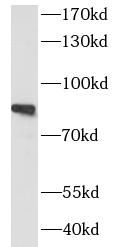Products
SIK1 antibody
Category:
Research Area:
- SPECIFICATIONS
- Product Name
- SIK1 antibody
- Catalogue No.
- FNab07866
- Size
- 100μg
- Form
- liquid
- Purification
- Immunogen affinity purified
- Purity
- ≥95% as determined by SDS-PAGE
- Clonality
- polyclonal
- Isotype
- IgG
- Storage
- PBS with 0.02% sodium azide and 50% glycerol pH 7.3, -20℃ for 12 months(Avoid repeated freeze / thaw cycles.)
Immunogen
- Immunogen
- salt-inducible kinase 1
- Alternative Names
- MSK antibody, salt inducible kinase 1 antibody, SIK antibody, SIK 1 antibody, SIK1 antibody, SNF1LK antibody
- UniProt ID
- P57059
- Observed MW
- 85 kDa
Application
- Tested Applications
- ELISA, WB, IHC, IF
- Recommended dilution
- WB: 1:500-1:1000; IHC: 1:50-1:500; IF: 1:10-1:100
Validated Images
 A549 cells were subjected to SDS PAGE followed by western blot with FNab07866(SIK1 antibody) at dilution of 1:600
A549 cells were subjected to SDS PAGE followed by western blot with FNab07866(SIK1 antibody) at dilution of 1:600
 Immunohistochemistry of paraffin-embedded human testis tissue slide using FNab07866(SIK1 Antibody) at dilution of 1:50
Immunohistochemistry of paraffin-embedded human testis tissue slide using FNab07866(SIK1 Antibody) at dilution of 1:50
- Background
- Serine/threonine-protein kinase involved in various processes such as cell cycle regulation, gluconeogenesis and lipogenesis regulation, muscle growth and differentiation and tumor suppression. Phosphorylates HDAC4, HDAC5, PPME1, SREBF1, CRTC1/TORC1 and CRTC2/TORC2. Acts as a tumor suppressor and plays a key role in p53/TP53-dependent anoikis, a type of apoptosis triggered by cell detachment: required for phosphorylation of p53/TP53 in response to loss of adhesion and is able to suppress metastasis. Part of a sodium-sensing signaling network, probably by mediating phosphorylation of PPME1: following increases in intracellular sodium, SIK1 is activated by CaMK1 and phosphorylates PPME1 subunit of protein phosphatase 2A(PP2A), leading to dephosphorylation of sodium/potassium-transporting ATPase ATP1A1 and subsequent increase activity of ATP1A1. Acts as a regulator of muscle cells by phosphorylating and inhibiting class II histone deacetylases HDAC4 and HDAC5, leading to promote expression of MEF2 target genes in myocytes. Also required during cardiomyogenesis by regulating the exit of cardiomyoblasts from the cell cycle via down-regulation of CDKN1C/p57Kip2. Acts as a regulator of hepatic gluconeogenesis by phosphorylating and repressing the CREB-specific coactivators CRTC1/TORC1 and CRTC2/TORC2, leading to inhibit CREB activity. Also regulates hepatic lipogenesis by phosphorylating and inhibiting SREBF1. In concert with CRTC1/TORC1, regulates the light-induced entrainment of the circadian clock by attenuating PER1 induction; represses CREB-mediated transcription of PER1 by phosphorylating and deactivating CRTC1/TORC1(By similarity).



